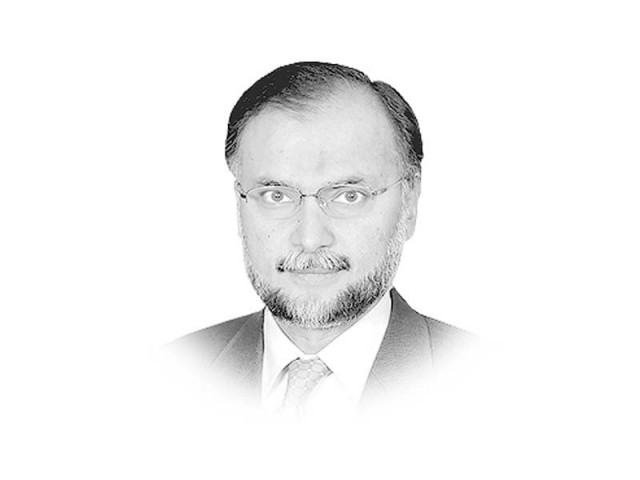Pakistan’s new development trajectory
Current federal PSDP has received the highest-ever allocation of funds in the country’s history: Rs1001 billion

The writer is federal minister of planning, development and reform. His twitter handle is @betterpakistan
The current federal PSDP has received the highest-ever allocation of funds in the country’s history: Rs1001 billion. In FY 2012-13, this amount was only Rs360 billion. This is an increase of 178 per cent. The allocation of funds in the current PSDP are predicated on the priorities set in Vision 2025: inclusive and sustainable development. Similarly, Rs1,112 billion have been allocated for development in provinces whereas in 2012-13 it was only Rs515 billion.
The current government is cognisant of the fact that there are regional disparities in Pakistan. Therefore, to materialise inclusive development in Pakistan, significant funds are allocated for historically disadvantages places. For Azad Jammu Kashmir (AJK) Rs22 billion are allocated in this PSDP. This is an increase of 120% as compared to 2012-13 when AJK only received Rs10 billion. Similarly, a sum of Rs15 billion is allocated for Gilgit-Baltistan in this PSDP as compared to Rs7 billion in 2012-13. This is an increase of 110%. The Federally Administered Tribal Areas (Fata) has historically been ignored by governments in Islamabad, to remedy this, we have increased Fata’s budget to Rs24.5 billion. It was only Rs16 billion in 2012-13. This is an increase of more than 50%.
New development projects for Faisalabad approved
The main driver behind this rise in PSDP and provincial development budgets has been the steady increase in revenues of the federal government via better tax collection. Tax-to-GDP ratio has increased to 12.6% for FY 2016. Back in FY 2013, it was only 9.8%. This reflects the improvement in governance and institutions.
In a short span of four years, the PML-N government has literally transformed the development portfolio of Pakistan. The most impressive thing about this PSDP is that it did not come at the expense of fiscal deficit. The fiscal deficit for FY 2016 is 4.6 per cent of the gross domestic product (GDP). In FY 2013 it was 8.2 per cent. Historically, governments in Pakistan in their last year of their tenure lose fiscal discipline. But this government has set a new trend by demonstrating fiscal responsibility and discipline and did not give into any election year pressures.
When the PML-N government assumed office in 2013 it set three priority areas: energy, infrastructure and education. In each area, the government has made major strides. In the energy sector, investments were only around Rs185 billion in 2012-13. Today, they stand at Rs404 billion — an increase of 118 per cent.
Road and rail networks are the backbone of any modern economy. Up to Rs411 billion have been allocated for infrastructure development in the current year. In stark contrast, only Rs142 billion were allocated for the same in 2012-13. This is an increase of 189%. Up to Rs180 billion have been allocated for CPEC projects. Because of the construction of highways and motorways, Pakistan will in the coming years become a hub for trade and commerce in the region. Moreover, efficient movement of goods will greatly improve the economy’s logistical competitiveness.
In an unprecedented manner Rs35.662 billion have been allocated for the Higher Education Commission (HEC) in the current PSDP. In FY 2012-13, HEC’s development budget was only Rs15 billion. Since PM Sharif assumed office, there has been a phenomenal increase (more than 100 per cent) in the allocation of funds to HEC within a span of four years. These investments will yield huge dividends in the long run. But even in the short run, higher education statistics have immensely improved in the last four years. There has been an 82% increase in merit-based scholarships in the last four years. Many new campuses have been started under the University Campus in Every District initiative. The US-Pakistan Knowledge Corridor is offering 10,000 PhD scholarships to the best and the brightest. A Rs1 billion Technology Innovation Fund has been set up to promote academia-industry link. Some 100,000 youth will be trained in Enterprise Resource Planning (ERP) softwares.
Under the Prime Minister’s Youth Initiative, Rs20 billion have been allocated in this PSDP. This includes the youth laptop programme, youth training scheme, fee reimbursement scheme, interest free loan schemes and skill development programme. These programmes will allow our youth to economically and digitally empower themselves and contribute positively to the development of Pakistan.
Similarly, Rs1 billion has been allocated for the Startup Pakistan initiative to promote entrepreneurship among youth. Startup Pakistan will address a perennial challenge of lack of risk capital within the local eco-system by setting up a publicly funded venture capital fund. This will fasten the pace of business registration and make it friendlier. A startup window on the Pakistan Stock Exchange will also be created. These steps are the single largest package of reforms aimed at enhancing the startup culture within the country.
Development schemes: Punjab govt allocates Rs1.2 billion
In today’s globalised world, it is important to promote a softer image of the country. Pakistan needs to be re-introduced in the global arena and our youth is best placed to do this. Our millennials have fresh and creative ideas and they are much more open towards diversity and adaptation. To concretise this, we have allocated Rs500 million for the Global Youth Internship Programme. We will send the brightest young minds of Pakistan to the top capitals of the world so that they can see how their political systems work. At the same time, these bright young people would get an opportunity to break the stereotypes about Pakistan in the world.
This is the age of the fourth industrial revolution and it has amplified technological bias in the processes of development. Therefore, it is imperative for Pakistan to avail these fourth industrial revolution technologies. With that in mind, the government has launched a programme of establishing hybrid research and innovation platforms in critical and emerging technology areas. Among them are national research centres for artificial intelligence, applied mathematics and higher performance computing, cyber security, robotics and automation, big data and cloud computing. These research centres will lay the foundation of technology-led development in Pakistan.
One of the most influential economic thinkers of the 20th century, John M Keynes, once said: “The difficulty lies not so much in developing new ideas as in escaping from old ones”. This is very apt in the case of Pakistan. In the sphere of economy the old idea that haunted us for very long was of ‘import substitution’; it did not allow us to build a competitive export-based industries.
In the political sphere, the old idea that has been most detrimental is of disrupting and dislodging elected civilian regimes. It spurs political instability. It is an established fact that no matter how good our economic policies are if we cannot ensure political stability, they will not yield the desired results. Therefore, it is imperative that we maintain political stability in Pakistan. The prerequisite for maintaining political stability is that democratic will and decisions of the people of Pakistan should prevail over everything else.
Published in The Express Tribune, June 20th, 2017.
Like Opinion & Editorial on Facebook, follow @ETOpEd on Twitter to receive all updates on all our daily pieces.


















COMMENTS
Comments are moderated and generally will be posted if they are on-topic and not abusive.
For more information, please see our Comments FAQ